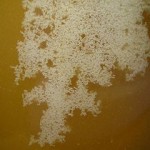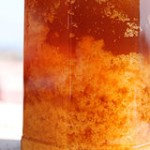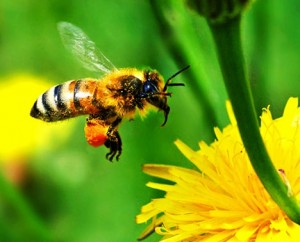 Many people when their runny golden honey turns thick, semi-solid and opaque become concerned that the product has gone off or in some way it is past its use by date. However this granulation or crystallisation is a natural process and all honey has a tendency to some degree to crystallise. Beekeepers call this ‘set honey’ and some honey eaters prefer it as it is easier to spread and is less messy.
Many people when their runny golden honey turns thick, semi-solid and opaque become concerned that the product has gone off or in some way it is past its use by date. However this granulation or crystallisation is a natural process and all honey has a tendency to some degree to crystallise. Beekeepers call this ‘set honey’ and some honey eaters prefer it as it is easier to spread and is less messy.
Honey crystallisation does not affect the flavour or nutritional content of the honey, though it does affect the colour and texture.
The rate at which crystallisation occurs depends upon storage temperature, availability of ‘seed’ crystals, such as pollen grains and the specific mix of sugars and trace compounds in the honey. Honey is a highly concentrated sugar solution, containing over 70% sugars and less than 20% water. The resultant solution is very unstable as the available water has a very high degree of sugar content making it more prone to crystallise.
The two main sugars in honey are fructose and glucose and the relative percentage of each varies from one type of honey to another. The general percentage range of the two types of sugars are fructose from 30- 44 % and glucose from 25- 40 %. It is the glucose in honey which crystallises as it has a lower water solubility, unlike fructose which is more soluble in water and therefore will remain fluid for longer.
Honey which is made from nectar that is higher in fructose content such as Tupelo Honey and Sage Honey are very slow to crystallise. While honey made from plants such as oilseed rape and ivy are lower in fructose and crystallise very rapidly, doing so on the comb in the hive. These latter types of honey need careful management by the beekeeper and even the bees can have problems managing this type of honey crop.
What happens when crystallisation occurs is the glucose has separated from the water and turned into small crystals,
 which eventually spreads throughout the honey. Most honey will crystallise uniformly but some just form a crystallised layer on the bottom of the container with the top remaining liquid. The quicker the crystallisation process occurs the finer the texture will be.
which eventually spreads throughout the honey. Most honey will crystallise uniformly but some just form a crystallised layer on the bottom of the container with the top remaining liquid. The quicker the crystallisation process occurs the finer the texture will be.
Crystallized honey usually sets to a much lighter colour than in its original runny form. This is caused by the glucose crystals which have separated and dried out and which are naturally white in colour, although dark honey will still be a brownish colour in appearance.
Apart from the relative sugar content of the honey, storage temperature and the amount of impurities in the honey also affects the rate of crystallisation. Honey crystallization is most rapid around 10-15 ºC (50- 59 ºF) and is slowed down or prevented at temperature below 10 ºC (52 ºF). Honey resists crystallization best at temperatures of more than 25 ºC (77 ºF). When the temperature reaches 40 ºC (104 ºF) crystals will dissolve. However temperature above 40 ºC (104 ºF) will damage the natural properties of honey.
The presence of harmless impurities in honey such as pollen grains and beeswax also speed up crystallisation as they act as seeds or nuclei for the crystals. These are perfectly natural and are part of what makes honey so nutritious and healthy and those seeking a more natural product should always look out for honey labelled as ‘raw honey’.
Commercially produced honey responding to public demand for a honey that does not tend to crystallise but remains runny or ‘squeezable’ tends to be filtered to remove any natural impurities. In addition it is often heated to temperatures above 40 ºC (104 ºF), which will remove sugar crystals and along with the filtering will keep the product runny for longer. But the taste and the natural goodness and nutritional value of the honey is much diminished.

